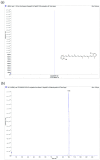Protective Effect of a Water-Soluble Carotenoid-Rich Extract of Cordyceps militaris against Light-Evoked Functional Vision Deterioration in Mice
- PMID: 35458237
- PMCID: PMC9031935
- DOI: 10.3390/nu14081675
Protective Effect of a Water-Soluble Carotenoid-Rich Extract of Cordyceps militaris against Light-Evoked Functional Vision Deterioration in Mice
Abstract
Light-evoked retinal photodamage is considered an important factor contributing to functional vision deterioration and can even lead to light maculopathy or dry age-related macular degeneration. Loss of visual acuity (VA) and visual contrast sensitivity function (VCSF) are the major symptoms of retinal degenerative diseases. Cordyceps militaris is a carotenoid-rich Chinese medicinal fungus with antioxidant, anti-inflammatory, and immunomodulatory functions. C. militaris extract is a natural substance, and its bioactive constituents have been shown to confer health benefits, but their application in retinal tissue and functional vision protection in vivo remain incompletely understood. In the present study, we evaluated the influence of water-soluble, carotenoid-rich C. militaris extracts on the visual performance of light-damaged mouse retinas in vivo, using adult female CD-1® (ICR) albino mice. We showed that oral administration of this C. militaris extract (10 mg/kg, twice daily) protected the neural retina tissue against light-evoked photoreceptor cell death, reduced Müller cell hypertrophic gliosis, and elevated GSH levels and promoted the recovery of VA- and VCSF-thresholds, especially for high spatial frequency-characterized vision. These results suggest that, probably because of its water-soluble carotenoids, C. militaris extract has the potential to prevent or treat light-induced visual dysfunction.
Keywords: Cordyceps militaris; cordyxanthins; functional vision; photoreceptor; retinal photodamage; visual contrast sensitivity function; water-soluble carotenoids.
Conflict of interest statement
The authors declare no conflict of interest.
Figures





Similar articles
-
Carotenoid Production by Caterpillar Medicinal Mushrooms, Cordyceps militaris (Ascomycetes), under Different Culture Conditions.Int J Med Mushrooms. 2020;22(12):1191-1201. doi: 10.1615/IntJMedMushrooms.2020036685. Int J Med Mushrooms. 2020. PMID: 33463936
-
Genotoxicity, acute and sub-acute toxicity profiles of methanolic Cordyceps militaris (L.) Fr. extract in Swiss Albino Mice.J Ethnopharmacol. 2024 Dec 5;335:118603. doi: 10.1016/j.jep.2024.118603. Epub 2024 Jul 25. J Ethnopharmacol. 2024. PMID: 39067832
-
Photoreceptor and vision protective effects of astragaloside IV in mice model with light-evoked retinal damage.Biomed Pharmacother. 2022 Sep;153:113404. doi: 10.1016/j.biopha.2022.113404. Epub 2022 Jul 12. Biomed Pharmacother. 2022. PMID: 36076531
-
Trends in the Immunomodulatory Effects of Cordyceps militaris: Total Extracts, Polysaccharides and Cordycepin.Front Pharmacol. 2020 Nov 30;11:575704. doi: 10.3389/fphar.2020.575704. eCollection 2020. Front Pharmacol. 2020. PMID: 33328984 Free PMC article. Review.
-
Advance in Cordyceps militaris (Linn) Link polysaccharides: Isolation, structure, and bioactivities: A review.Int J Biol Macromol. 2019 Jul 1;132:906-914. doi: 10.1016/j.ijbiomac.2019.04.020. Epub 2019 Apr 4. Int J Biol Macromol. 2019. PMID: 30954592 Review.
Cited by
-
The association of MIND diet with cognitive resilience to neuropathologies.Alzheimers Dement. 2023 Aug;19(8):3644-3653. doi: 10.1002/alz.12982. Epub 2023 Feb 28. Alzheimers Dement. 2023. PMID: 36855023 Free PMC article.
-
Discovering a novel glycosyltransferase gene CmUGT1 enhances main metabolites production of Cordyceps militaris.Front Microbiol. 2024 Oct 22;15:1437963. doi: 10.3389/fmicb.2024.1437963. eCollection 2024. Front Microbiol. 2024. PMID: 39502416 Free PMC article.
References
MeSH terms
Substances
LinkOut - more resources
Full Text Sources

